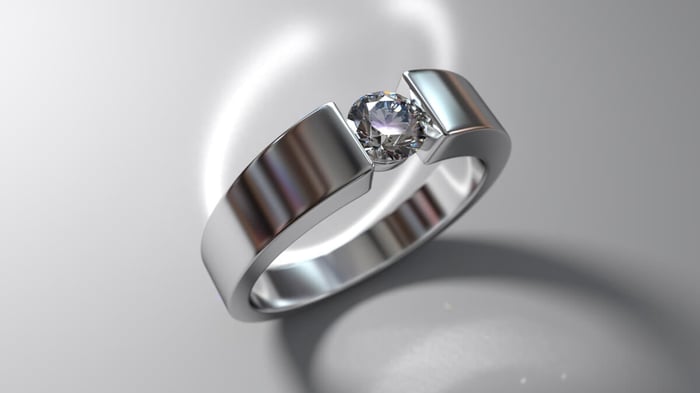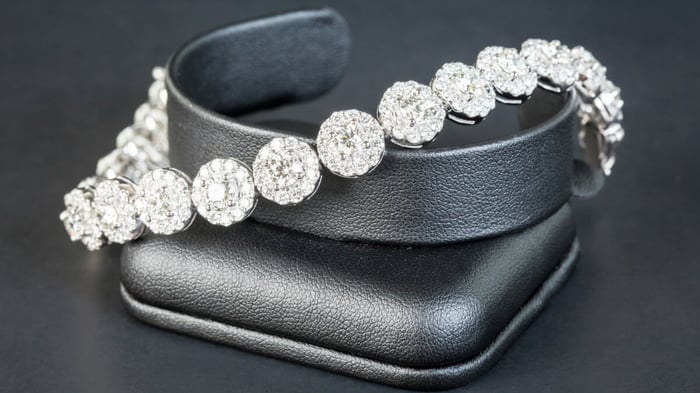Tension Set Diamond Jewellery
Tension set diamond jewellery is becoming very popular nowadays, but tension set jewellery is still an unusual sight. The concept of tension settings has been known for around 50 years. A piece of jewellery that uses a tension setting will have a sleek, modern appearance that will mystify anyone who has never seen this advanced setting technique. Rest assured, the suspended effect is not trickery or magic - this is science, based upon advanced metallurgy techniques!
In this article, we will look at how tension settings work and dispel any concerns you might have about them! By the time you have finished reading, if you were thinking of choosing jewellery using a tension setting, you will feel confident about your choice!
How Do Tension Settings Work?
It is possible to make tension-set diamond jewellery in platinum, yellow, rose or white gold with a special alloy by using a technique that allows the material to have a memory of its position. Depending on the style, tension set products can exert anywhere from 30 to 45 kilos of pressure on the centre diamond. That is not enough to harm a diamond, the world's hardest natural substance.
The precious metals are treated with pressure or thermal treatment to securely prepare the metal to hold the diamond or other precious stone. The special treatment of the precious metal results in the metal having a certain springiness, which will allow the diamond to be held without the need for prongs or a bezel. Lasers are used to measure the exact size of the gemstone so that the gap into which the diamond will be placed can be set perfectly for every diamond. The diamond is pressed by the ends of the ring on each side. The metal has expertly cut, tiny grooves that grip the diamond. These grooves are called the 'seat', which engage with a part of the diamond's girdle.
The finished jewellery has a stunning effect visual effect.
While the floating effect of a tension setting has magic all of its own, this is not the only factor that makes a tension setting so attractive. Because the diamond is held by only a small part of the girdle and there is no metal beneath the stone, light can readily travel through the diamond from almost every angle. The result is that a tension-set diamond will appear more brilliant and with more sparkle than a ring that uses a bezel (rub over) setting or a prong setting.
What Diamond Shapes Work Best With A Tension Setting?
The two shapes of diamonds that are most often seen in a tension setting are round cut and princess cut. However, almost any diamond shape can be used in a tension setting. This versatility makes tension settings very popular with our clients who commission a custom-made piece of fine diamond jewellery!
Common Worries About Tension Settings
Some people worry that the diamonds in a tension setting are not held securely, which is not surprising given that the diamond appears to float between two pieces of metal with no visible setting. However, a tension-set ring is considered safe, often safer than four-prong settings, as prongs can get looser over the years.
Another concern is that the diamond could be prone to chipping or breakage. This is absolutely not true. Diamonds can be damaged in any setting, but the tension set mountings can cover more of the girdle compared to other types of settings, resulting in a little better protection than many prong settings.
A Prong setting can be bent back by only a slight pressure against a hard surface, point or tool. Still, tension settings hold the diamond over a much wider area of the girdle, and the entire setting must be sprung away from the stone to remove it.
Brazalete de diamantes en engarce de tensión Diamante G/SI de 0,33 quilates en oro blanco de 18 k

€2.603,95
Este brazalete de diamantes en oro blanco de 18 k está diseñado para usarse en la mano. Este brazalete agrega elegancia clásica a cualquier atuendo. Más popular como regalo de compromiso para mujeres, este brazalete es más que un simple… read more
Since the whole point of tension setting is that the metal is highly conditioned to work as a spring, slight deflections that might, under certain circumstances, move the setting apart a bit don't hurt as the setting instantly springs back to its original position. This is due to its being engineered as a compression spring.
The tension setting does not need to exert much force on the gem to hold it in place. While it is true that a strong enough force or impact can dislodge a tension set diamond, a similar impact on a prong-set diamond would also be likely to loosen the diamond or damage the setting such that repair would be required.
Lastly, some people believe that tension-set diamond rings can't be resized, but there is no truth to this concern. Tension set rings can be resized a full ring size up or down. However, resizing a tension set ring requires a skilled technician, so do not entrust such work to just anyone! We can handle resizing for you, should it be necessary, but it is always better to get the size right at the time of purchase!
Tension Settings Are Not Only For Rings!
We love tension settings, and our designers have created beautiful bangles, earrings, pendants and bracelets that incorporate tension-set diamonds to great effect. You can see some examples of the work of our British designers and artisans on this page.
If you want a piece of diamond jewellery that looks unique and always attracts attention, then a tension setting, whether in a ring or other jewellery, is a great choice!
Like all of our jewellery, every piece of tension set jewellery has our lifetime workmanship guarantee and a 30-day exchange and return service to ensure that you get the right piece of fine diamond jewellery that will last for a lifetime!
Please check out our tension set bracelets, bangles and other fine jewellery. We are confident that you will find a design that inspires and delights you!




